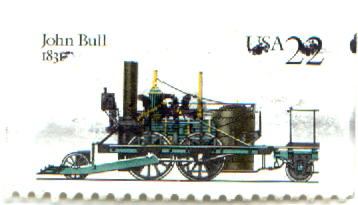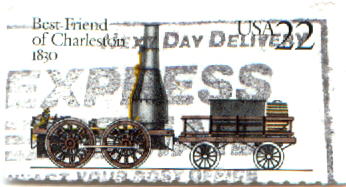New Developments
 A combination of technological and entrepreneurial innovations, such as the invention of
tracks, the creation of steam-powered locomotives, and the development of trains as public
carriers of passengers and freight, brought forth the railroad. By 1804, English as well
as American inventors had experimented with steam engines for moving land vehicles. In
1820, John Stevens ran a locomotive and cars around in a circular track on his New Jersey
estate, which the public saw as an amusing toy. And in 1825, the Stockton and Darlington
Railroad in England became the first line to carry general traffic after opening a short
length of track. American businessmen, especially in those the Atlantic coastal region that
looked for better communication with the West, quickly became interested in the English
experiment.
A combination of technological and entrepreneurial innovations, such as the invention of
tracks, the creation of steam-powered locomotives, and the development of trains as public
carriers of passengers and freight, brought forth the railroad. By 1804, English as well
as American inventors had experimented with steam engines for moving land vehicles. In
1820, John Stevens ran a locomotive and cars around in a circular track on his New Jersey
estate, which the public saw as an amusing toy. And in 1825, the Stockton and Darlington
Railroad in England became the first line to carry general traffic after opening a short
length of track. American businessmen, especially in those the Atlantic coastal region that
looked for better communication with the West, quickly became interested in the English
experiment.
The first company to begin actual operations was the Baltimore and Ohio, which opened a thirteen-mile length of track in 1830[3]. It used a team of horses that pulled a train of passenger carriages and freight wagons along the track. Steam locomotive power did not come into regular service until two years later. The dream of connecting Baltimore and the Ohio River by railroad did not come true until the 1850s[4]. In 1831, the Mohawk and Hudson in New York began running trains between Schenectady and Albany in 1831, a distance of sixteen miles. By 1836, more than 1,000 miles of track had been laid in eleven states[5].
But the railroad was not born with the importance later generations would give it. It was not viewed as being essential to economic development. On the contrary; railroads were generally seen as having only limited commercial use. Extreme skeptics emphasized the dangers of the railroad. They argued that the unrefined tracks were unsuitable for regular service, that the sparks thrown off by the engines would set fire to buildings and fields, and that speeds of 20 or 30 miles an hour could be dangerous to the wagons, road and loading, and human life. More sober critics expressed doubts about the ability of railroads to provide low-cost transportation, especially for heavy freights. Even railroad executives seem to have had a limited conception of the role of the railroads at first. The first undertakings expected to make their profit by carrying passengers, by serving small localities, and by serving as subsidiary routes to waterways. Keeping in mind the cost of construction and maintenance, canals were considered the most advantageous means of communication. Railroads, however, were given preference when high speeds were concerned for moving passengers and under circumstances of competition[6].
There was not yet a true railroad system. Even the longest of the lines was relatively
short in the 1830's, and most of them served simply to connect water routes to each other,
not to link one railroad to another. Even when two lines did connect, the tracks often
differed in width, so cars from one line could not fit onto the tracks of the next. Schedules
were unreliable and wrecks were frequent. But the railroads saw some important developments
in the 1830's and 1840's. Roadbeds were improved through the introduction of heavier iron
rails.
 Steam locomotives became more flexible and powerful. Passenger cars were redesigned to be
stabler, more comfortable, and larger[7].
By the end of 1830, twenty-three miles of track had been built in the country. Just ten
years later, almost three thousand miles had been constructed. By that early age, the
United States already surpassed Great Britain in railroad
construction[8] .
Steam locomotives became more flexible and powerful. Passenger cars were redesigned to be
stabler, more comfortable, and larger[7].
By the end of 1830, twenty-three miles of track had been built in the country. Just ten
years later, almost three thousand miles had been constructed. By that early age, the
United States already surpassed Great Britain in railroad
construction[8] .
